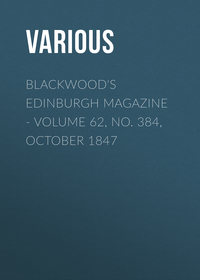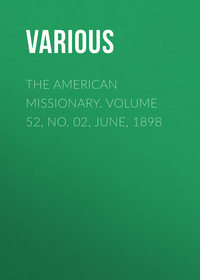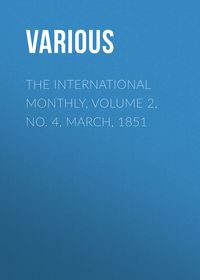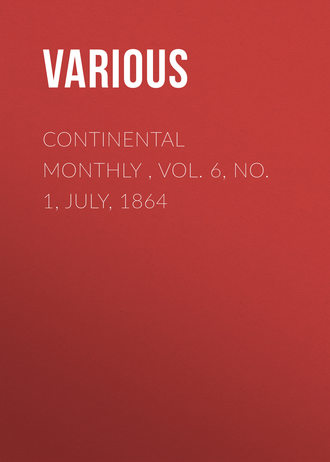 полная версия
полная версияContinental Monthly , Vol. 6, No. 1, July, 1864

Various
Continental Monthly , Vol. 6, No. 1, July, 1864 / Devoted to Literature and National Policy
AN ARMY: ITS ORGANIZATION AND MOVEMENTS
SECOND PAPER
Having, in the preceding paper, described the general organization1 of an army, we proceed to give a succinct account of some of the principal staff departments, in their relations to the troops.
Army organization—notwithstanding the world has always been engaged in military enterprises—is of comparatively recent institution. Many of the principles of existing military systems date no farther back than to Frederic the Great, of Prussia, and many were originated by Napoleon. Staff departments, particularly, as now constituted, are of late origin. The staff organization is undergoing constant changes. Its most improved form is to be found in France and Prussia. Our own staff system is of a composite, and, in some respects, heterogeneous character—not having been, constructed on any regular plan, but built up by gradual accretions and imitations of European features, from the time of our Revolution till the present. It has, however, worked with great vigor and efficiency.
The staff of any commander is usually spoken of in two classes—the departmental and the personal—the latter including the aides-de-camp, who pertain more particularly to the person of the commander, while the former belong to the organization. Of the departmental staff, the assistant adjutant-generals and assistant inspector-generals are denominated the 'general staff,' because their functions extend through all branches of the organization, while the other officers are confined exclusively to their own departments.
The chief of staff is a recent French imitation. The first officer assigned in that capacity was General Marcy, on the staff of General McClellan, in the fall of 1861. Previous to that time the officers of the adjutant-general's department—on account of their intimate relations with commanding officers, as their official organs and the mediums through which all orders were transmitted—had occupied it. The duties of these officers, however, being chiefly of a bureau character, allowing them little opportunity for active external supervision, it has been deemed necessary to select for heads of the staffs, officers particularly qualified to assist the commander in devising strategical plans, organizing, and moving troops, etc.; competent to oversee and direct the proceedings of the various staff departments; untrammelled with any exclusive routine of duty, and able in any emergency, when the commander may be absent, to give necessary orders. For these reasons, although the innovation has not been sanctioned by any law, or any standing rule of the War Department, and although its propriety is discussed by many, the custom of assigning officers as chiefs of staff has become universal, and will probably be permanent. The extent and character of their duties depend, however, upon themselves, being regulated by no orders, and the high responsibilities attached to the position in France have not thus far been assumed by the officers occupying it here. In the French service, the chief of staff is the actual as well as the nominal head of the organization; he supervises all its operations; he is the alter ego of the commander. In the Waterloo campaign, for instance, Marshal Soult was the chief of Napoleon's staff, and the emperor attributed his disaster, in part, to some of the orders issued by the marshal.
Our limits will not permit a description of the duties pertaining to the various members of the staff, but we pass to the consideration of those departments, the operations of which most directly affect the soldier, are indispensable to every army, and are most interesting to the public.
Let us first consider the quartermaster's department, which, from the character and diversity of its duties, the amount of its expenditures, and its influence upon military operations, may be ranked as among the most important. This department provides clothing, camp and garrison equipage, animals and transportation of all kinds, fuel, forage, straw, and stationery, an immense variety of the miscellaneous materials required by an army, and for a vast amount of miscellaneous expenditures. It is, in fact, the great business operator of a military organization. In an active army, the success of movements depends very much on its efficiency. Unless the troops are kept properly clothed, the animals and means of transportation maintained in good condition, and the immense trains moved with regularity and promptness, the best contrived plans will fail in their development and execution.
The department, at the commencement of the war, had supplies in store only for the current uses of the regular army. When the volunteer forces were organized it became necessary to make hasty contracts and purchases to a large amount; but as even the best-informed members of the Government had no adequate prevision of the extent and duration of the war, and of the necessary arrangements for its demands, a considerable period elapsed before a sufficient quantity of the required materials could be accumulated. Those were the days of 'shoddy' cloth and spavined horses. The department, however, exhibited great administrative energy, under the direction of its able head, General M. C. Meigs, and has amply provided for the enormous demands upon it.
Depots for the reception of supplies are established in the large cities, whence they are transferred as required to the great issuing depots near the active armies, and from them to the depots in the field. Thus, the main depots of the Army of the Potomac are at Washington and Alexandria—a field depot being established at its centre, when lying for any length of time in camp. Only current supplies are kept on hand at the latter, and no surplus is transported on the march, except the required amounts of subsistence and forage.
A great deal is said in connection with military movements, of 'bases of operation.' These are the points in the rear of an army from which it receives supplies and reënforcements, and with which its communications must at all hazards be kept open, except it has means of transportation sufficient to render it independent of its depots for a considerable period, or unless the country traversed is able to afford subsistence for men and animals. When an army marches along a navigable river, its secondary base becomes movable, and it is less confined to the necessity of protecting its rear. In Virginia, however, the connection of the Army of the Potomac with Washington is imperative, and this fact explains the contracted sphere of the operations of that army.
The transportation of supplies is limited by the ability of the Government to provide trains, and by the ability of the army to protect them; for large trains create large drafts on the troops for teamsters, pioneers, guards, etc. An army train, upon the most limited allowance compatible with freedom of operations for a few days, away from the depots, is an immense affair. Under the existing allowances in the Army of the Potomac, a corps of thirty thousand infantry has about seven hundred wagons, drawn by four thousand two hundred mules; the horses of officers and of the artillery will bring the number of animals to be provided for up to about seven thousand. On the march it is calculated that each wagon will occupy about eighty feet—in bad roads much more; consequently a train of seven hundred wagons will cover fifty-six thousand feet of road—or over ten miles; the ambulances of a corps will occupy about a mile, and the batteries about three miles; thirty thousand troops need six miles to march in, if they form but one column; the total length of the marching column of a corps is therefore twenty miles, even without including the cattle herds and trains of bridge material. Readers who have been accustomed to think that our armies have not exhibited sufficient energy in surmounting the obstacles of bad roads, unbridged streams, etc., will be able to estimate, upon the above statements, the immense difficulty of moving trains and artillery. The trains of an army have been properly denominated its impedimenta, and their movement and protection is one of the most difficult incidental operations of warfare—particularly in a country like Virginia, where the art of road making has attained no high degree of perfection, and where the forests swarm with guerillas.
To an unaccustomed observer the concourse of the trains of an army, in connection with any rapid movement, would give the idea of inextricable confusion. It is of course necessary to move them upon as many different roads as possible, but it will frequently happen that they must be concentrated in a small space, and move in a small number of columns. During the celebrated 'change of base' from Richmond to Harrison's Landing, the trains were at first obliged to move upon only one road—across White Oak Swamp—which happened fortunately to be wide enough for three wagons to go abreast. There were perhaps twenty-five hundred vehicles, which would make a continuous line of some forty or fifty miles. While the slow and toilsome course of this cumbrous column was proceeding, the troops were obliged to remain in the rear and fight the battles of Savage Station and White Oak Swamp for its protection. A similar situation of trains occurred last fall when General Meade retired from the Rappahannock, but fortunately the country presented several practicable routes. It is on a retreat, particularly, that the difficulty of moving trains is experienced, and thousands of lives and much valuable material have been lost by the neglect of commanding officers to place them sufficiently far in the rear during a battle, so as to permit the troops to fall back when necessary, without interruption.
A march being ordered, supplies according to the capacity of the trains, are directed to be carried. The present capacity of the trams of the Army of the Potomac is ten days' subsistence and forage, and sixty rounds of small-arm ammunition—the men carrying in addition a number of days' rations, and a number of rounds, upon their persons. When the wagons reach camp each evening, such supplies as have been expended are replenished from them. As a general rule the baggage wagons camp every night with the troops, but the exigencies are sometimes such that officers are compelled to deny themselves for one or even two weeks the luxury of a change of clothing—the wagons not reaching camp, perhaps, till after midnight, and the troops resuming their march an hour or two afterward. Those who indulge in satires upon the wearers of shoulder straps would be likely to form a more correct judgment of an officer's position and its attendant hardships, could they see him at the close of a fortnight's campaign. Like the soldier, he can rely on nothing for food or clothing except what is carried by himself, unless he maintains a servant, and the latter will find a few blankets, a coffee pot, some crackers, meat, sugar, coffee, etc., for his own and his employer's consumption, a sufficient burden.
Let us see how the supplies of the quartermaster's department are distributed.
At stated periods, if circumstances permit—usually at the first of each month—the regimental quartermasters, after consultation with the company officers, forward through their superiors to the chief quartermasters of corps, statements of the articles required by the men. These are consolidated and presented to the chief quartermaster of the army, who orders them from Washington, and issues them from the army depot—the whole operation requiring about a week. The number of different kinds of articles thus drawn monthly is about five hundred; the quantity of each kind depends on the number of men to be supplied, and the nature of the service performed since the previous issue. If there has been much marching, there will be a great demand for shoes; if a battle, large quantities of all kinds of articles to replace those lost on the battle field will be required.
An infantry soldier is allowed the following principal articles of clothing during a three years' term of service:
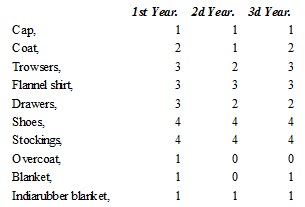
The prices of these are stated each year in a circular from the department, and, as the soldier draws them, his captain charges him with the prices on the company books. The paymaster deducts from his pay any excess which he may have drawn, or allows him if he has drawn less than he is entitled to. The clothing is much cheaper than articles of the same quality at home. Thus, according to the present prices, a coat costs $7.30; overcoat, $7.50; trowsers, $2.70; flannel shirt, $1.53; stockings, 32 cents; shoes, $2.05.
The commissary department provides exclusively the subsistence of the troops. Each soldier is entitled to the following daily ration:
Twelve ounces of pork or bacon, or one pound four ounces of fresh beef.
One pound six ounces of soft bread or flour, or one pound of hard bread, or one pound four ounces of corn meal.
To every one hundred men, fifteen pounds of beans or peas, and ten pounds of rice or hominy.
To every one hundred men, ten pounds of green coffee, or eight pounds of roasted, or one pound and eight ounces of tea.
To every one hundred men, fifteen pounds of sugar, four quarts of vinegar, one pound four ounces of candles, four pounds of soap, three pounds twelve ounces of salt, four ounces of pepper, thirty pounds of potatoes, when practicable, and one quart of molasses.
Fresh onions, beets, carrots, and turnips, when on hand, can be issued in place of beans, peas, rice, or hominy, if the men desire.
They can also take in place of any part of the ration an amount equal in value of dried apples, dried peaches, pickles, etc., when on hand.
A whiskey ration of a gill per day per man can be issued on the order of the commander, in cases of extra hardship. It is, however, rarely issued, on account of the difficulty of finding room for its transportation in any considerable quantities. Moreover, whiskey, in the army, is subject to extraordinary and mysterious leakages, and an issue can scarcely be made with such care that some drunkenness will not ensue. When lying in camp, sutlers and others sell to the soldiers contrary to law, so that old topers usually find methods of gratifying their appetites—sometimes sacrificing a large proportion of their pay to the villains who pander to them. The utmost vigilance of the officers fails to detect the methods by which liquor is introduced into the army. When a cask is broached in any secluded place, the intelligence seems communicated by a pervading electrical current, and the men are seized with a universal desire to leave camp for the purpose of washing, or getting wood, or taking a walk, or other praise-worthy purposes.
The total weight of a ration is something over two pounds, but in marching, some articles are omitted, and but a small quantity of salt meat is carried—fresh beef being supplied from the herds of cattle driven with the army. A bullock will afford about four hundred and fifty rations, so that an army of one hundred thousand men needs over two hundred cattle daily for its supply.
In camp the men can refrain from drawing portions of their rations, and the surplus is allowed for by the commissaries in money, by which a company fund can be created, and expended in the purchase of gloves, gaiters, etc., or luxuries for the table. A hospital fund is formed in the same way—by an allowance for the portions of the rations not consumed by the patients—and is expended in articles adapted to diet for the sick. The rations are ample and of good quality, though the salt meat is rather tough occasionally, and the consistency of the hard bread is shot-proof. Company cooks are allowed, and in camp they contrive to furnish quite appetizing meals. Their position is rather difficult to fill, and woe is the portion of the cook not competent for his profession. The practical annoyances to which he is subject make him realize to the fullest extent 'the unfathomable depths of human woe.' On the march the men usually prefer to boil their coffee in tin cups, and to cook their meat on ram-rods—without waiting for the more formal movements of the cooks. To reach camp before sunset, after a twenty-mile march, to pitch his little shelter tent, throw in it his heavy arms and accoutrements, collect some pine twigs for a couch, wash in some adjacent stream, drink his cup of hot, strong coffee, eat his salt pork and hard bread, and then wrap himself in his blanket for a dreamless slumber, is one of the most delicious combinations of luxurious enjoyment a soldier knows. To-morrow, perhaps, he starts up at the early reveille, takes his hasty breakfast, is marshalled into line before the enemy, there is a shriek in the air rent by the murderous shell, and the soldier's last march is ended.
The next department we shall consider is that of ordnance, which supplies the munitions and portions of accoutrements.
The subject of artillery is perhaps the most interesting of the great number connected with warfare. In the popular estimation it overshadows all others. All the poetry of war celebrates the grandeur of
'Those mortal engines whose rude throatsThe immortal Jove's dread clamors counterfeit.'The thunder of great guns and the dashing of cavalry are the incidents which spontaneously present themselves to the mind when a battle is mentioned. Perhaps the accounts of Waterloo are responsible for this. The steady fighting of masses of infantry, having less particulars to attract the imagination, is overlooked; the fact, preëminent above all others in military science, that it is the infantry which contests and decides battles, that artillery and cavalry are only subordinate agencies—is forgotten. So splendid have been the inventions and achievements of the last few years in respect to artillery, as illustrated particularly at Charleston, that some excuse may easily be found for the popular misconception. A few remarks presenting some truths relative to the appropriate sphere of artillery and its powers, and stating succinctly the results which have been accomplished, may be found interesting.
Without entering into the history of artillery, it will be sufficient to state that the peculiar distinguishing excellence of modern improvements in cannon is the attainment of superior efficiency, accuracy, and mobility, with a decrease in weight of metal. A gun of any given size is now many times superior to one of the same size in use fifty or a hundred years ago. It is not so much in big guns that we excel our predecessors—for there are many specimens of old cannon of great dimensions; but by our advance in science we are able so to shape our guns and our projectiles that with less weight of material we can throw larger shot to a greater distance and with more accuracy. A long course of mathematical experiment and calculation has determined the exact pressure of a charge of powder at all points in the bore of a cannon during its combustion and evolution into gas. These experiments have proved that strength is principally required near the breech, and that a cannon need not be of so great length as was formerly supposed to be necessary. We are thus able to construct guns which can be handled, throwing balls of several hundred pounds' weight. Another splendid result of scientific investigation is the method adopted for casting such monster guns. In order that the mass of metal may be of uniform tenacity and character, it should cool equably. This has been secured by a plan for introducing a stream of water through the core of the casting, so that the metal cools both within and without simultaneously.
About the time that the Italian war commenced, the subject of rifled cannon excited much popular interest. Exaggerated expectations were formed of the changes to be produced by them in the art of warfare. Many saw in them the means of abolishing war entirely. Of what use is it, they said, to array armies against each other, if they can be destroyed at two or three miles' distance? At the commencement of our own contest there was an undue partiality for rifled ordnance. Almost every commander of a battery desired to have rifled guns. The more correct views of the thoroughly accomplished artillery officers to whom was confided the arrangement of this branch of the service, and actual experience, have dissipated the unfounded estimate of their utility for field service, and established the proper proportions in an artillery force which they should compose. It has been ascertained that fighting will never be confined to long ranges—that guns which can throw large volumes of spherical case and canister into lines only a few hundred yards distant are as necessary as ever.
The necessity for rifled cannon arose from the perfection of rifled muskets. When these arms reached such a degree of excellence that horses and gunners could be shot down at a distance of one thousand yards, the old-fashioned smooth-bore artillery was deprived of its prestige. To retrieve this disadvantage and restore the superiority of artillery over musketry in length of range, methods of rifling cannon for field service became an important study. For assailing distant lines of troops, for opening a battle, for dispersing bodies of cavalry, for shelling intrenchments, for firing over troops from hills in their rear, rifled guns are of invaluable service. But, notwithstanding troops are now universally armed with muskets of long range, no battle of importance is fought without close engagements of the lines. The alternate advances and retreats of the infantry, firing at distances of less than one hundred yards, charging with fixed bayonets and frantic shouts, will always characterize any battle fought with vigor and enthusiasm. In such conflicts, wide-mouthed smooth bores, belching their torrents of iron, must play a conspicuous part.
Another fact, which will perhaps surprise the general reader, is that the form and character of projectiles have been matters of as much difficulty, have received as much investigation, and are of as much importance, as the shape and character of the guns. In fact, rifled pieces would be comparatively ineffective except projectiles adapted to them had been invented. It was necessary that projectiles of greater weight, of less resistance to the atmosphere, and of more accuracy of flight, than the old round shot, should be introduced. To accomplish these ends several things were necessary: 1st, the projectiles should be elongated; 2d, they should have conical points; 3d, the centre of gravity should be at a proper distance in front of the centre; 4th, there should be methods of steering them so that they should always go point foremost through the whole curve of their flight; 5th, they should fit the gun so as to take the rifles, yet not so closely as to strain it. To attain these and other requisites, innumerable plans have been devised. The projectile offering the best normal conditions is the arrow; it has length, a sharp point, centre of gravity near the head, and feathers for guiding it (sometimes so arranged that it shall rotate like a rifled ball). Improved projectiles, therefore, both for muskets and cannon, correspond in these essentials to the first products of man in the savage state.
We cannot, in this article, further discuss either such general principles or those of a more abstruse character, in their application to artillery, but will briefly state a few facts relative to its employment—confining ourselves exclusively to the field service.
The guns now principally used for battles, in the Northern armies, are 10 and 12-pounder Parrotts, three-inch United States rifles, and light 12-pounder smooth bores. The distinguishing characteristic of the Parrott guns is lightness of construction, secured by strengthening the breech (in accordance with the principles mentioned a few paragraphs back) with a band of wrought iron. This has been applied to guns of all sizes, and its excellence has been tested by General Gillmore in the reduction of Forts Pulaski and Sumter. The three-inch guns are made of wrought iron, are of light weight, but exceedingly tenacious and accurate. The 12-pounders, sometimes called Napoleons, are of bronze, with large caliber, and used chiefly for throwing shell and canister at comparatively short distances.






